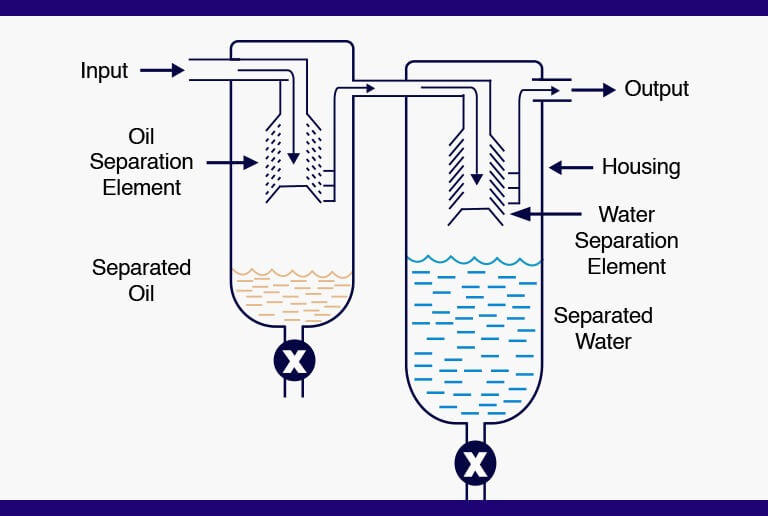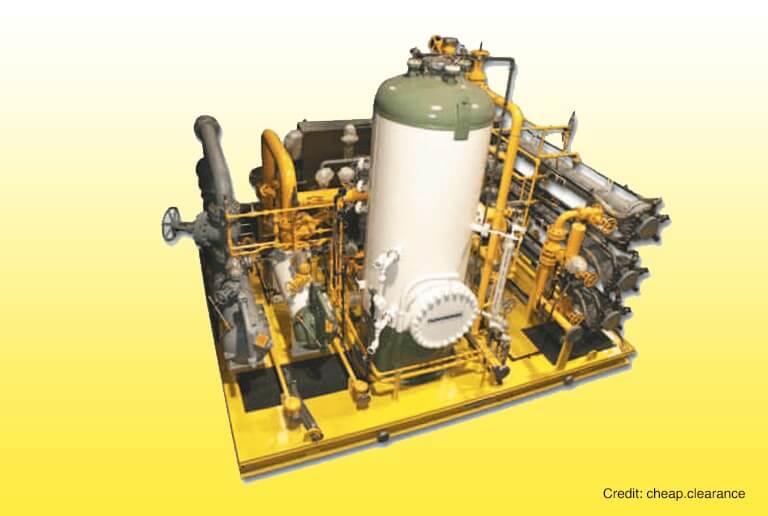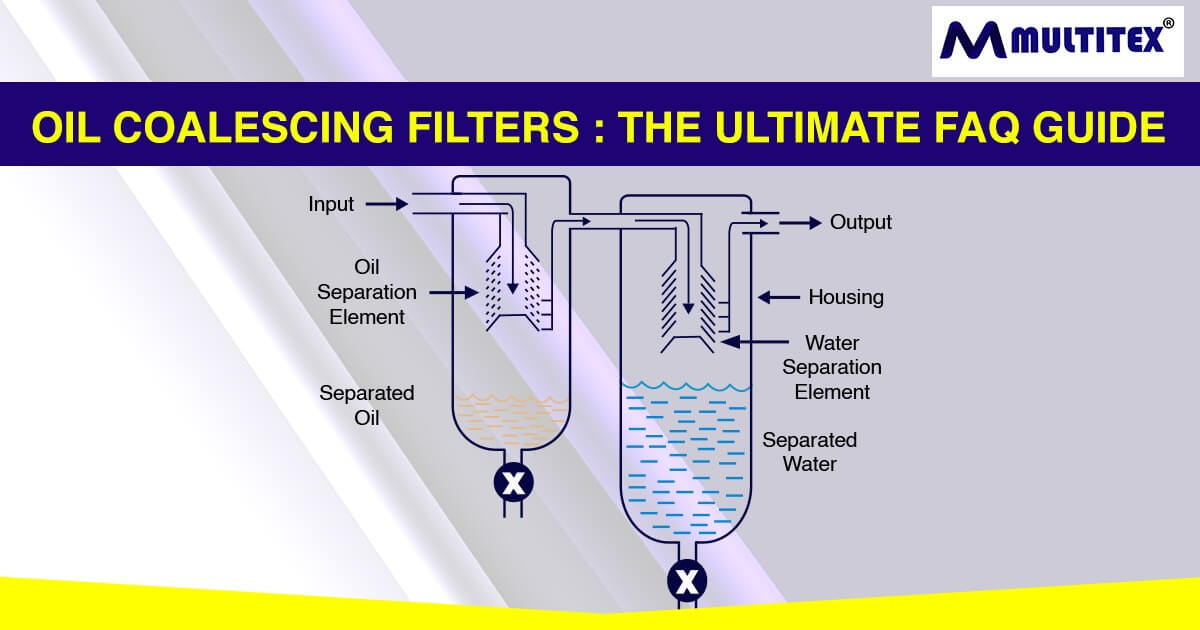What is an Oil Coalescing Filter?
A coalescing filter is a component used in large industries, oil and gas plants, and chemical plants to separate homogenous and heterogeneous substances and mixtures.
Oil coalescing filters are filters that help remove impurities and contaminants like liquid oil and aerosols from compressed air used in processing units.
Many industries and manufacturing units have compressed air or gas chambers that are a part of their production process. Many times, compressed air or gas is contaminated with oil particles that contaminate it.
A Coalescer Filter Separator equipment helps in removing the oil impurities and other contaminants like dust, dirt, solid waste, and liquid waste from the chambers.
In some cases, such filters are also used in the water-oil interphase, which is a sub-process of liquid-liquid filtration. These filters may be used as an independent unit at times and in other cases, they may be a part of a bigger filtration process and can be used as an intermediate step to filter out air streams as it goes through the next stages.
How Does An Oil Coalescing Filter Function?
As mentioned above, an oil coalescing filter helps remove oil impurities and contaminants in air and gas streams.
Coalescence is a process by which two or more elements combine to form another substance. In an oil filter, coalescence causes liquid aerosols to mix together, creating bigger droplets.
These droplets get so big due to coalescence that they are pulled down by gravity. This process is called agglomeration. These larger oil particles then collect at the bottom of the filter chamber. An effective coalescing filters separator can filter out even micron-sized oil particles effectively by combining them with other similar particles.
These coalescent particles reach the bottom of the extraction chamber using gravity. These can then be removed out through the drainage outlet.
Why else is an oil coalescence filter beneficial?
Apart from helping filter out oil contaminants, this filter is used for another more vital purpose too. Thanks to working the pneumatic equipment regularly, oil and other contaminants may clog up the pipes and tubing systems. This will cause the pipes and the tubes to get damaged and eroded with time.
This can lead to the malfunctioning of the processing system with time. Using an oil coalescence filter will improve the integrity of the processing unit and make sure the overall pollution levels in the processing unit, including water, dust, liquid, and vapor reduce with time.
Top features of an Oil Coalescing Filter?
If you want to invest in oil coalescence filters, here are some of the features you should look for in them.
- A corrosion-resistant body
- High rate of filtration efficiency
- High micron rating to filter out the smallest of elements
- Effectively withstands fiber shredding
- Does not experience media migration
- Ability to function regularly with minimal breakdowns or repair
- Can be customized to choose the right flow rate, temperature, pressure, and filtration rate
Where are Oil Coalescing Filters Used?
Oil coalescence filters are used in a variety of industries, a few of which are mentioned below.
| Industries | Usage of oil coalescing filters |
| Oil and gas | Liquid-liquid or liquid-gas separation |
| Petrochemical | Liquid-liquid or liquid-gas separation; expelling oil and water vapor at the end stage |
| Pulp and paper mills | Liquid-liquid or liquid-gas separation |
| Chemical processing plants | Liquid-liquid or liquid-gas separation |
| Water processing plants | Liquid-liquid or liquid-gas separation |
What are the contaminants removed by oil coalescing filters?
Oil coalescence filters help eliminate solid and liquid contaminants of specified micron sizes. Some of these contaminants are:
- Emulsified and non-emulsified oil
- Diesel
- Gasoline
- Carbonized oil
- Water (condensed moisture)
- All kinds of fuel
- Dust and dirt
- Rust
Classifying Oil Coalescing Filters
Depending on the mode of operation and design, there are different types of oil coalescing filters available. Some of the common classifications to know about are mentioned below.
| Oil coalescing filters based on the mode of operation | Features |
| Mechanical Coalescers | Uses physical filters to filter contaminantsCommonly used in oil and gas industriesAbility to remove impurities smaller than 0.010 ppm |
| Electrostatic Coalescers | Uses electricity to form coalescence dropletsElectrostatic charge increases the size of droplets and causes them to fall into the chamber/tankCan use both AC and DC current |
| Oil coalescing filters based on Design | Features |
| Simplex oil Coalescers | Simple one-piece structure to filter impuritiesCompressed air or gas flows through a chamber, where coalescence happens and impurities get trappedIt is easy to maintain these models |
| Duplex oil Coalescers | Uses dual chambers – two filter chambers that are connected by switching valvesEach chamber functions independent of the other Ability to function as a simplex model even if one chamber failsHas minimal or no downtime due to dual chambers |
How does the Oil Coalescing Filter Work?
Below are the detailed steps of how a coalescing filters separator works.
STEP 1: The compressed air or gas is let into the filter chamber and is allowed to flow through the filter media.
STEP 2: The filter media has multiple filter elements and these trap aerosol impurities and contaminants effectively.
STEP 3: Larger impurities particles are successfully trapped in the media. The coalescence process then makes tinier contaminants bigger in size so that they are affected by gravity and are collected at the bottom tank.
STEP 4: Finally, pure air or gas exits the filter through the outlet port.
What Factors Affect the Performance of your Oil Coalescer?
Your oil coalescer filter may be of the best quality available in the industry. However, the below are factors that can improve or deteriorate the performance of the filters.
- Viscosity and surface tension of the oil
- Velocity of the liquid
- Size of the filter pores
- Material of the filter media
- Size of the housing and filter unit
- Property of the filter media
- Age of the filter
- Size of the contaminants
Before you choose the filter, make sure you check all these features. A good manufacturer will be able to answer all your queries and help you decide on the right model with the right features.
What Are Filter Elements and how to Choose the Right Filter Element?
A filter element is a very important part of the filter media that traps aerosol impurities and other contaminants using processes like diffusion, interception, or direct impact methods.
The type and size of the filter element finally determine how effective the filtration process is.
A filter element primarily consists of filter meshes that capture impurities in the gas/air stream. The more minute the filter meshes, the better will be the filtration process. Also, the larger the filter element, the more quicker and effective will be the filtration.
The filter elements have to be designed in a way that saves the cost of operation, increases efficiency, and maintains an optimal running environment. Filter elements that are smaller in size invariably offer a better filtration rate. All these filter elements come with a micron rating. Check this value before deciding the right element.
Primary Parts of an Oil Coalescing Filter

Below are the primary parts of any oil coalescing filter.
- Input pipe/inlet pipe – This is the place from which contaminated air or gas enters the coalescence filter.
- Separation element – This is the place the actual filtration process happens. The filter element is a part of the separation element. There can be different separation elements for different impurities.
- Sump – A tank to collect oil or water that was coalesced and collected.
- Outlet drain – Outlet that lets the collected contaminants (oil or water) drain away from the filter. These are recycled or discarded.
- Housing – External structure that holds all the parts of the filter together.
- Outlet pipe – Helps the filtered air/gas pass out of the filter for further use.
How does Coalescing Filtration Differ from Particulate Filtration?
Particulate filters are another type of popular filter used in industrial applications. A particulate filter helps separate solid particles (impurities) from an incoming liquid or gas input. Different types of filters do this job depending on how contaminated the input is and the efficiency required.
A coalescing filter, however, removes liquid drops and aerosol drops from gas or air inputs. In the process, coalescence is also able to remove other particle contaminants like dust, dirt, and rust too.
Oil coalescing filters, in other terms, works just like a particulate filter. But as an extra addition, coalescing filters are also able to remove aerosol droplets and water droplets from the air or gas interphase.
How To Select a Coalescing Filter?
Materials that can be used for the Coalescing Filter Element
There are a lot of different types of filter elements that can be used in a coalescence filter. The materials will be chosen depending on how contaminated the air or gas is and the rate of filtration needed. Some filter materials have a better filtration rate than others.
Some of the commonly used filter element materials are:
- Micro-glass
- Closed-cell foam
- Fiberglass
- Lattice
- Polyester fibers (synthetic)
- polypropylene
Why should you install more than one Coalescing Filter?
A lot of experts recommend the use of two coalescing filters instead of just one. There are a lot of reasons for this.
- Both filters can be designed to eliminate contaminants of different sizes
- Two times filtration helps improve purity levels
- It reduces the pressure put on the filters and hence improves the life of the equipment
- Reduces filtration time, thanks to dual-functioning
- Brings down operational costs over time
- Can prevent filter downtime and even if one filter fails, the other will work
Can You Pair Oil Coalescing Filters?

Pairing oil coalescing filters is more advantageous than using a single filter, especially when your production process is completely dependent on filtered air or gas. Stalling the production process for even a few hours because of filter problems can lead to considerable monetary loss. By pairing oil coalescing filters, you can cut back on this risk.
Cleaning Oil Coalescing Filters
Even though a filter is supposed to clean/purify substances, the fact that the filter media and the housing unit are constantly exposed to contaminants makes them contaminated over time too. Once every 1-2 months, the inner sponge unit can be removed and completely washed and replaced.
Make sure you may need to hire an expert to clean the accumulated dirt, dust, and other pollutants that have accumulated at the bottom of the tank a couple of times a year.
The idea behind washing a coalescing filters separator is simple. The more the filter is used, the more frequently it will need to be cleaned. The ideal cleaning period is every two months.
Self-cleaning filters
When you have multiple filters installed or have large filter structures in the production place, manually cleaning these can become a challenge. It may take considerable effort to clean the setup completely. That’s why self-cleaning filters may help. Self-cleaning oil coalescing filters are designed to identify quality markers and when the quality falls below a pre-set value, can initiate self-cleaning.
Factors that play a role while installing an oil coalescing filter
It is advantageous when you install your oil coalescing filter at the highest pressure point inside the compression system. This way, the pressure of the air or gas will help improve filtering efficiency. Similarly, high temperatures can damage the filtering equipment. Make sure you install the filter in a position where the temperature is at its lowest.
Both these factors, when considered while installation, will help improve the performance, efficiency, and life of the filter.
Should you install other devices along with the Oil Coalescing Filter?
Some industries use a general filtration system along with the oil coalescing filter to eliminate all possible contaminants from the air or gas source. This improves the purity of the output. Influent and effluent pump packages are also parts of the system in some places. Installing alarms to notify the person in charge in case of an emergency or a fault is a good idea. It is mandatory in most industrial settings too. Sight glasses are easy ways to notice what is happening inside the housing unit and identify problems early on.
Replacing the Oil Coalescing Filter
All filter elements need to be replaced within the time mentioned by the manufacturer irrespective of whether or not the element is damaged. Using the same filter element beyond the stipulated time is going to reduce the effectiveness of the filtration process.
Within the usage time, if you notice a pressure drop or if the amount of contaminants is higher in the filtered gas or air, then you may have to change the filter.
For lighter applications, the oil coalescence filter may last for even up to 36 months. For more intensive applications though, the lifetime may be lesser. Consult the manufacturer to understand the exact recommended functional periods of these filter elements.
How to maintain an Oil Coalescing Filter?
There are three steps to maintaining an oil coalescing filter – Inspection, Usage, and Maintenance
- Inspection – You must inspect the filter every 4-8 weeks. This will help identify faults before they become big.
- Usage – All filters come with a user manual and instructions on how many hours the filters can run, what kind of substances they are designed to filter, and the maintenance details. Make sure you follow these instructions to ensure the filter has maximum usage.
- Maintenance – All oil coalescing filters need to be maintained from time to time. Maintenance will include cleaning, repair work, and giving the filter ample rest between periods of functioning. Maintaining the filter well will improve its lifespan.
Read More: Backwash Filters: The Ultimate Automatic Backwash Filters
Conclusion
Oil coalescing filters are integral additions to many industries that need pure air or gas for use.
You may be having standard filters installed already. However, do know that these standard filters usually only eliminate particulate contaminants and cannot handle liquid oil or oil aerosols that may infiltrate and bring down the quality of air or gas stream.
For these contaminants, the best option is to use a coalescing filters separator along with the regular filter that you have.
The size of the housing and the filter element need to be decided based on individual needs. Multitex is a global engineering and manufacturing company that has worked with industries in the oil, gas, and power sectors across the world.
Trust us to identify your needs and create filtration equipment that improves production efficiency and brings down operational costs.
Multitex excels in creating innovative and practical solutions that are tailor-made to the needs of our clients for the last 50 years. Our in-house manufacturing and engineering facilities are run by experts in the field and are accredited by international organizations.
If you have any queries on how an oil coalescing filter can help your business grow, get in touch with Multitex.
